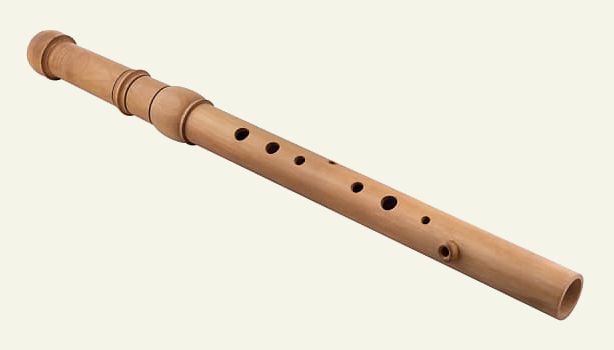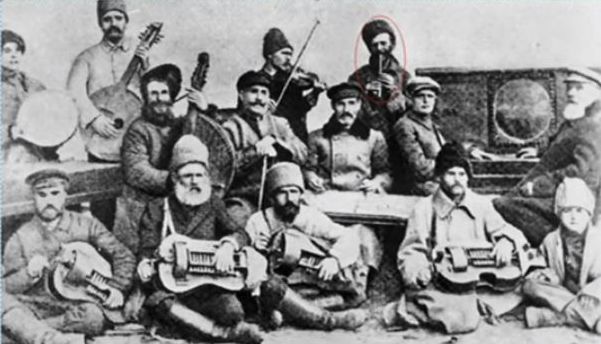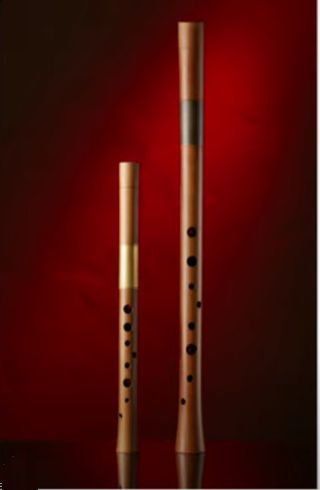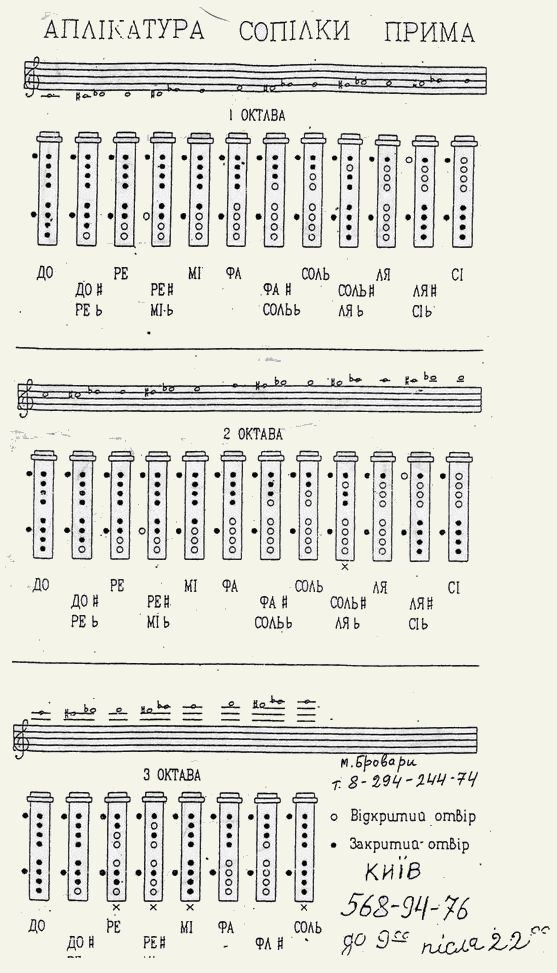Ukrainian Chromatic Recorder
The music of Ukraine features many unique instruments. Prominent amongst these are the bandura, kobza, torban, and sopilka. In its most sophisticated form, the sopilka (сопілка) is a fully chromatic internal duct flute. Like the recorder, the sopilka had its origin in the diatonic six-holed pipe, but it represents a separate and far more recently developed branch from that leading to the recorder. Whereas the recorder has holes for the thumb and three fingers of the upper hand and all four fingers of the lowermost hand, the chromatic sopilka has holes for all ten digits: thus there are two thumb holes, one for each hand. In addition to being fully chromatic the modern sopilka is highly expressive and capable of astonishingly rapid playing. Skilled sopilka performers can mimic a variety of sounds found in nature, including bird calls and insect noises.


Traditional forms of the Ukrainian duct-flute with 5-6 finger holes (денцівка, denchivka) were diatonic, with a range of up to two octaves, or so. The denchivka is known from the Princely era of the Kyivan Rus and is depicted on an 11th-century fresco in Kyiv’s Saint Sophia Cathedral. In folk tradition, it was commonly the instrument of shepherds or part of trio ensembles and various wedding bands.

With the nationalist revival of the 20th century, the denchivka, like other folk instruments, became the subject of experimentation aimed at adapting the instrument for use in a modern context, notably by Ivan Mykhailovych Sklyar, Yevhen Bobrovnykov, and Vasyl Zuliak. The results of this work included improvements in intonation, tonal stability, volume, and compass. In 1967 the chromatic 10-hole fingering system was developed by instrument maker Dmytro Florovych Demenchuk (1942–2010). Serial production of chromatic soprano sopilkas began at the Melnytsia–Podilska experimental production workshops established by Zuliak.
The chromatic fingering system has since been further improved and applied to other members of what is by now a distinctive sopilka family — the piccolo tuned in F5 (equivalent to a sopranino recorder), prima in C5 (equivalent to a soprano recorder), altos in G4 and F4, and tenor in C4. Sopilkas have been made in wood, metal, plastic, and ebonite.
Today, the modern sopilka is heard most often deputising for its ancestors in folkloric instrumental ensembles recreating and repurposing the traditional music of the various sub-ethnicities in western Ukraine, notably that of the Hutsuls of the Carpathian Mountains.
Ukrainian Medley, featuring Maksim Popichuk (sopilka, ocarina, panpipe)
Bukovinian Folk Melodies & Dance, featuring Maksim Popichuk (sopilka)
The sopilka has found a place in Klezma music, too.
S’em Sorok, a Jewish song about a train from Odessa due at seven forty, but which arrives much later when “the flame of Odessa is on fire”. Played by the Lemon Bucket Orkestra (Toronto, Canada), a Balkan-Klezmer-Gypsy-Party-Punk-Super Band, with Mike Romanik playing sopilka
Popular bands have also made use of the sopilka in their performances. Amongst the first to do so was the folk-music-inspired vocal and instrumental ensemble, Kobza. which toured widely throughout the former Soviet Union and internationally.
More recently, the sopilka has found its way into the music of Eurovision 2004 winner, the mononymous Ruslana (band led by Ruslana Stepanivna Lyzhychko), folk-rock band Haydamaky, Ukrainian-Canadian speed-folk band Kubasonics, electro-folk band ONUKA, and other contemporary groups which explore Ukrainian themes.
The 2022 Eurovision contest in Turin was won by the Ukraine Kalush Orchestra whose performance of Stefania incorporates traditional folk instruments, including the telenka (an overtone flute played with one hand controlling its open end) and the beat-boxing tenor sopilka player Vitali Duzhik.
In a sense, the sopilka has evolved from a folk instrument to become something of a national symbol, nowhere better demonstrated than by the leader of the band KoraLLi, Myshko Adamchak, and his Rock Sopilkar project. Myshko has become a celebrity of late for his solo sopilka performances on the Ukraine front where he is currently doing military duty as an ambulance paramedic.
Arkan, a traditional Hutsul circle dance performed by Myshko Adamchak (sopilka) with the band KoraLLi and Orchestra
The modern chromatic sopilka was first championed as an instrument worthy of serious academic study by composer, teacher, accordionist and sopilka player Myroslav Korchynsky (1941–2021) who established the Lviv School of Professional Sopilka Performance at the Mykola Lysenko National Music Academy. Largely as a result of Korchinsky’s efforts, the sopilka is increasingly heard in performances of renaissance, baroque, classical, romantic, and contemporary music (much of it familiar to recorder players) performed by highly accomplished players, most notably his daughter, Bozhena Korchynska. There are many videos featuring such playing on YouTube, amongst them the following:
Ciaccona by Johann Heinrich Schmelzer (c.1620–1680), performed in the Organ Hall, Lviv by Bozhena Korchynska (sopilka) and Berhard Hofstötter (lute)
Trio-sonata by Stanisław Sylwester Szarzyński
(fl. 1692–1713), performed by Bozhena Korchynska (sopilka),
Radosław Kamieniarz (violin) and Irmina Obońska (organ )
Concerto in A minor (originally for oboe) by Antonio Vivaldi (1678–1741), RV 461, performed by Bozhena Gamar (sopilka) and Sinfonietta Chamber Orchestra of the Vasyl Barvinsky Music College, Drohobych, conducted by Roman Bagriy
Fantasie, Op. 37 by Ernest Krähmer (1795–1837), performed in Katowice (2015) by Bozhena Korchynska (sopilka) and Marek Toporowski (piano). Originally for the csakan (keyed recorder). Krähamer was born in Lviv.
Toccata: Lullaby for a Colibri (hummingbird) by Markus
Zahnhausen, performed by Bozhena Korchynska (sopilka)
Bozhena Korchynska has been the initiator of a new experimental model of sopilka in collaboration with her compatriot, recorder maker Jewgenij (Eugene) Ilarionov, with the goal of developing an instrument that more fully meets the needs of the professional performer. These requirements include those affecting volume over all registers, timbre, response, expressiveness, stability of intonation (even with strong air pressure), range, finish and durability of materials, and aesthetics of external design.

Ilarionov’s new sopilka design made corrections to the scale of the instrument, the internal bore profile, and the morphology of the window/labium. Applied to the alto sopilka, the result is a more responsive instrument, with a more stable lower register, greater volume flexibility, and a timbre rich in overtones, especially in the lower register. Additionally, the instrument is more aesthetically pleasing to view and more comfortable in the hand. These characteristics are amply demonstrated in the following performance.
Concerto for flute, strings & bc., by Giovanni Battista. Ferrandini (1710–1791), performed by Olga Milosta (sopilka), Solomiya Korchynska (piano)
Applied to the soprano sopilka, these changes have been somewhat less successful with issues related to ease of register change and responsiveness in the higher register yet to be fully addressed.
Like recorders, sopilkas of different sizes can be played together as a consort. Myroslav Korchynsky was the founder of the first professional ensemble of sopilka players, Dudalis, in 1980 which, now in its fifth generation, continues to perform as Quartet Dudalis The basset chromatic sopilka (in F3) held by Myroslav Korchynsky in the photograph below was created on his initiative in 1990 by instrument maker Petro Yevtropovich Malynovsky in Kyiv.
Take Five! by Paul Desmond (arr. Andrij Jackiv) performed by Dudalis, 2002
Chromatica, presented by Quartet Dudalis, 2021
It seems that sopilkas larger than the tenor are as yet neither standardised nor in serial production. However, an extraordinary set of bass sopilkas was made for the Folklore Orchestra of the Ukrainian Society of the Blind in Kamyianets–Podilskyi, founded in 1964 by a very talented and completely blind musician, Borys Gulashevsky. Gulashevsky, in collaboration with fellow musician Peter Tsinkalov, constructed a series of keyed bass sopilkas of different sizes for the orchestra ranging from a basset in G3 98 cm long, bass in C3 1.44 m long, sub-bass in G2 1.87 m long, contrabass in C2 2.61 m long, and sub-contrabass in E1 2.95 m long. Two sets of these unique instruments were made: one was taken to Russia by Gulashevsky; the other remains where it belongs in Kamyianets. Although their range is modest, these enormous sopilkas add great depth to the sound of the Folklore Orchestra, perhaps better described as a sopilka band or extended consort.

The Folklore Orchestra of the Ukrainian Society of the Blind performs in Melnytsia
Fingering Chart

Sopilka Makers
- Acropolis (Lviv): sopilkas in soprano, alto, tenor and basset sizes in three series: Student (SAT), Historical (SAT), and Colibri (SATB).
- Jewgenij Ilarianov: soprano and alto sopilkas after those of Dmitro Demintchuk, and after designs made in colloboration with performer Bozhena Korchynska.
- Yaroslav Loshak: piccolo, soprano, alto and tenor sopilkas after his own designs.
References
- Дверій оман Є. [Dverij, Roman Y.] 2008. Школа гри на хроматичніу сопілці. [Method for Playing the Chromatic Sopilka]. Parts 1–3. Centre for Creativity of Children and Youth of Galicia, Lviv. Part 2 is available online at https://dokumen.tips/documents/dverij-sopilka-shkola-gry-chast-2.html Parts of this publication were published in the form of lessons in the magazine «Україна» [Ukraine] (1984–1985), and the newspaper «Зірка» [Star] (1987–1989), which greatly contributed to the spread of the use of the sopilka among a large circle of devotees of Ukrainian folk music.
- Горбуленко Віталій [Gorbulenko, Vitali]. 2016. Сопілка більша за сопілкаря [A sopilka bigger than its player]. «Газета Подолянин» [Podolyanin Gazette], 1 February 2016. http://podolyanin.com.ua/culture/10544/
- Facebook: Quartet “Dudalis”. https://www.facebook.com/UkrainianRecorderQuartetDudalis/photos
Корчинська Божена [Korchynska, Bozhena].2021. Пастушка у двірцевих шатах. Історія професійного сопілкового виконавства. [A Shepherdess in Royal Robes: A History of Professional Sopilka Playing.] YouTube: https://www.youtube.com/watch?v=-jrKRhaQoqU- Korchynska, Bozhena. 2016. Ukrainian Chromatic Recorder. YouTube: https://youtu.be/b30ApRaqJ0Q
- Корчинська-Яскевич Божена Мирославівна [Korchinska-Yaskovich, Bozhena Myroslavivna]. 2017. Витоки і становлення професійної сопілкової культури в просторі українського інструменталізму [Origins and Formation of Professional Association Culture in the Context of Ukrainian Instrumentalism]. Ph.D. dissertation. Lviv: National Music Academy M. Lysenko. УДК 78.481. https://lnma.edu.ua/wp-content/uploads/2015/12/diss_korchynska.pdf.
- Корчинська Божена [Korchynska, Bozhena]. 2023. Історія хроматичної поздовжньої флейти/сопілки. [History of the Chromatic Vertical Flute/Sopilka.] YouTube: https://youtu.be/xTXugxs-rLQ
- Libin, Laurence (ed.) 2014. Sopilka. In: The Grove Dictionary of Musical Instruments. Vol. 4. 2nd edn. Oxford University Press, Oxford / New York. Page 557f.
- Лічкевич Юлія [Lichkevich, Julia]. 2020. Єдиний в Україні оркестр сліпих сопілкарів діє в Кам’янці-Подільському [The only orchestra of blind pipers in Ukraine operates in Kamianets-Podilskyi] «Край Кам’янецький» [Krai Kamianetskyi]. Published 4 March 2020. http://kray-kp.org.ua/kultura/iedynyi-v-ukraini-orkestr-slipykh-sopilkariv-diie-v-kamiantsi-podilskomu.html
- Struk, Danylo Husar (ed.) 1993. Encyclopedia of Ukraine. Vol. 5. University of Toronto Press.
- Wikipedia. 2022. Kobza (band). https://en.wikipedia.org/wiki/Kobza_(band)
- Wikipedia. 2021. Sopilka. https://de.wikipedia.org/wiki/Sopilka
- Wikipedia. 2022. The Lemon Bucket Orkestra. https://en.wikipedia.org/wiki/The_Lemon_Bucket_Orkestra
- YouTube 2017–. Ukraine TV (UATV) Channel (English). National Musical Instruments. Posted 8 April 2017. https://youtu.be/5YLgIzbahYE
- YouTube 2011–. Bozhena Korchynska’s Channel. https://www.youtube.com/c/BoshenaKorchynska
- YouTube 2021–. Maksim Popichuk’s Channel. https://www.youtube.com/c/MaksimPopichuk
- YouTube. 2013–. Суспільне Хмельницький [Melnytsia Society (Channel)]. Єдиний в Україні оркестр сліпих сопілкарів діє на Хмельниччині [The only orchestra of blind pipers in Ukraine performs in Melnytsia]. Posted 2 March 2020. https://youtu.be/sKyjZRqooI4
Little Solomia from Dnipro plays her ‘sopilka’ to raise money to support the brave defenders of Ukraine
Cite this article as: Nicholas S. Lander. 1996–2024. Recorder Home Page: Sopilka. Last accessed 25 April 2024. https://www.recorderhomepage.net/sopilka/